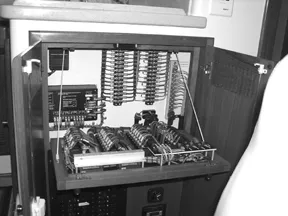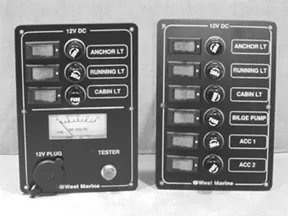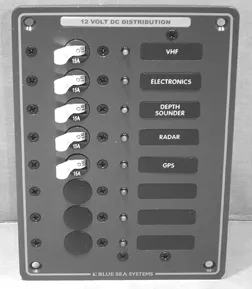
You just finished adding some important electronics to your boat—let’s say a new VHF, and a combination knotmeter-depthsounder. Now, how do you get electricity to these items? Install a small accessory electrical panel, of course.
The American Boat and Yacht Council (ABYC) calls a panelboard “a collection of circuit breakers, switches, and instrumentation installed into a panel which provides the central point for power distribution and monitoring for electrical systems.” Panel boards are commonly referred to as circuit breaker, distribution, fuse, or electrical panels.
Depending on the size of the vessel and the complexity of its DC system, power distribution may be centralized on a full-size circuit breaker panel or branched out to sub-panels. These smaller sub-panels could consist of simple fuse-protected switch panels, accessory circuit breaker panels, water-resistant panels, or any combination thereof.
The latest trend in DC distribution panels is the introduction of water-resistant auxiliary panels for the cockpit. These new panels allow local control out on the weather deck of accessory equipment, eliminating that all-too-familiar trip back into the cabin to turn a circuit on or off at the main distribution panel.
What We Evaluated
We limited our test field to three- to-eight-position panels with and without metering. These smaller DC panels are the choice when 12V accessories/electronics are added to a vessel. We looked at two switch-fused panels from West Marine, four circuit breaker panels from BEP, Newmar and Blue Sea Systems, two circuit breaker panels with metering from Blue Sea, and three water-resistant panels from Blue Sea and BEP.
We grouped the panels into economy panels; accessory circuit breaker panels, metered breaker panels, and water-resistant panels.
How We Evaluated
We focused on the quality of the panel’s components, the type of circuit protection provided, readability of the panel at night, serviceability, price, and warranty. For the night readability test, we powered up each panel’s night illumination circuit (the West Marine panels, the Blue Sea No. 8273 and the Newmar panel do not have provisions for night illumination) with 12V DC and rated the visibility of a circuit label at arms length from the toggle. In evaluating the serviceability of each panel, we practiced swapping out a circuit breaker (as applicable) and adding a complement of circuit labels to each panel.
Economy DC Fuse Panels
West Marine offers two entry-level 12V DC panels, both with SAE glass-fuse protection (see photo above). Although the styling of these panels is circa 1960, they are well assembled for the price ($40 for the six-position 55342 panel and $44 for the three-position 55344), which includes a 12V receptacle and analog voltage meter). The switch positions on these panels come pre-painted with Anchor Lt., Cabin Lt., Bilge Pump, etc., and do not ship with any self-adhesive circuit labels. You are going to need a P-touch label maker to customize and properly label the circuits for your specific application. The attachment method for both the main 12V positive and negative feed wires is via push-spade connectors. We prefer the security of a screw terminal attachment.
DC Panels Without Metering
The following four panels are good representations of what to look for in a quality DC accessory circuit breaker panel: BEP Marine No. 901 V DC, Blue Sea Systems Nos. 8023 and 8677, and Newmar No. ACCY-1X. We define an accessory panel as a panel that is circuit-breaker protected, capable of five to eight circuits, and designed for interior installations.
BEP Marine’s model No. 901 switch panel is the most expensive vertical panel of the accessory panel group that we reviewed ($213). This is because this panel ships with eight installed circuit breakers, whereas the other vertical panels from Blue Sea and Newmar come standard with only five circuit breakers pre-installed. We had a tough time fitting the BEP 901 with circuit labels. The instruction sheet says to remove the front cover of the panel via four No. 2 square-drive screws located at the back of the panel. It was a battle of balance and dexterity to get the screws back into the BEP panel. Granted, you normally only have to label a breaker panel once when it is new (unless you’re adding another accessory at a later date) but it still shouldn’t be this hard, in our view. Circuit label installation on all of the other panels was straightforward.

BEP’s 901 features modern Euro-styling (see photo opposite page) and contains both background night lighting for circuit identification and LED circuit activation indicator lights. One important difference between the 901 and the other accessory panels is that BEP keeps the DC negative connection points away from the panel. BEP provides a separate DC negative terminal strip that is to be mounted away from the panel. This “remote” negative terminal strip greatly reduces the chances of arcing out a circuit when troubleshooting a faulty circuit from the rear of the panel, because the negative buss bar has been physically relocated off the panel. This configuration makes for a very clean and easy-to-wire distribution panel.
Blue Sea Systems’ No. 8023 panel (see photo pg. 7) comes equipped with five pre-installed breakers and room for three spare breakers (same as the Newmar). The Blue Sea panel has similar night and circuit activation lighting to the BEP 901 panel. The 8023 ships standard with white handle circuit breakers, but can be special ordered with black toggles (at no additional charge). Aesthetically, we would have preferred black handle breakers.
The attachment points of the positive and negative feed cables are made via dedicated, threaded stud connections. We consider this type of connection method the best.
When an application calls for a horizontal accessory distribution panel, the Blue Sea No. 8677 is a great choice. This panel has all of the fine construction details of the 8023, but its circuit switches have black-faced “rocker” style switches. This style of switching makes it less likely to inadvertently flick off more than one circuit at a time.
Newmar’s ACCY 1X panel is a perennial favorite, but its styling is getting a little dated, in our view. The ACCY 1X is an easy panel to work with, but it lacks the circuit identification night lighting found on the BEP and Blue Sea panels. Both the BEP and Blue Sea panels provide circuit identification labels for radar, GPS, VHF, stereo, electronics, autopilot, and depthsounder, whereas the Newmar panel provides only one similar label—Nav/com. More extensive electronic label sets can be ordered from Newmar.
Metered Panels
In addition to the standard DC accessory panels, we obtained two high-end accessory panels from Blue Sea that had analog (Model No.8081) and digital (Model No. 8401) meters. (Neither is pictured here).
These panels are pricey when compared to meterless panels (list price for the dual analog panel is $298), but they are definitely top-shelf products that would complement any vessel.
Water-Resistant Panels
When an application calls for controlling the DC power to accessories on deck or in open cockpits, Blue Sea’s new 4300 WeatherDeck series of water-resistant panels is an excellent choice. The 4306 panel that we reviewed features bi-colored LED panel lighting and can be mounted either horizontally or vertically. The dual-position mounting is achieved by the use of “square” circuit labels, which can be rotated to match the panel’s orientation. This innovative panel is well built and worthy of high praise.
Conclusions
Whenever installing or replacing anything electrical onboard your vessel, planning, understanding the system, and knowing your own capabilities are paramount. Every panel manufacturer that we reviewed has a technical support department that welcomes calls and email from both novice and professional alike. And every panel that we reviewed came with installation instructions.
All of the accessory panels that we reviewed (with the exception of the economy panels) are constructed of aluminum and are fitted with Carling Technologies circuit breakers. But that is where the similarities end. Blue Sea and Newmar use thicker aluminum stock than BEP on their panels. The thicker stock allows Blue Sea and Newmar to counter-sink their mounting screw holes, making for a neater installation. The BEP panels must be mounted with pan head screws, which could chip the finish on the panel if small flat washers under the screw heads are not used.
When we took a closer look at the Carling Technologies circuit breakers used on all of the accessory and full-size panels from our review group, we noticed that Blue Sea is using a different model Carling circuit breaker than both BEP and Newmar. Blue Sea dubs the model of Carling that they are using as their “World Circuit Breaker.” The most striking difference of this circuit breaker is that its rated amperage is stenciled right on its face, below the toggle handle and in clear view from the front side of the panel. This location is very helpful in quickly accessing preliminary electrical problems without the need to remove the panel.

In the night readability test of our panels, BEP and Blue Sea won hands down, because Newmar doesn’t offer a lamp plate to illuminate their circuit labels. The entire Newmar panel remains dark at night, with the exception of the tiny LED “circuit energized” lamp. Blue Sea does not offer any meter lighting on their No. 8081 twin analog meter panel, just circuit identification and status illumination.
Blue Sea Systems is the only manufacturer that offers, in writing, a lifetime guarantee. Simply put, “If you are not satisfied with a Blue Sea product you can return it for a full refund or a replacement, at any time.” This is definitely a warranty and a manufacturer that is worth noting.
Bottom Line: The Blue Sea panels are backed by an impressive warranty, have excellent night lighting, and better labeling than the other panels. That’s why model No. 8023 is our top pick for an accessory circuit breaker panel, and model No. 4306 is our choice for a water-resistant panel.
Either of the West Marine switches are a good choice if you’re operating on a tight budget and need to replace a panel of switches on an older vessel.
Also With This Article
“Stepping Up to 24 V DC”
“Value Guide: DC Electrical Distribution Panels”
“Choosing the Right Panel”
“DIY Installation Tips From the Pros”
Contacts
• BEP, 877/730-3700, www.bepmarine.com
• Blue Sea Systems, 800/222-7617, www.bluesea.com
• Newmar, 714/751-0488, www.newmarpower.com
• West Marine, 800/262-8464, www.westmarine.com
































